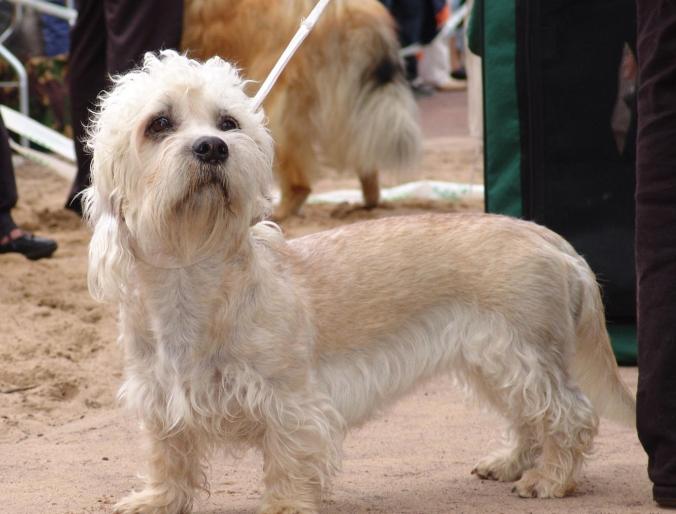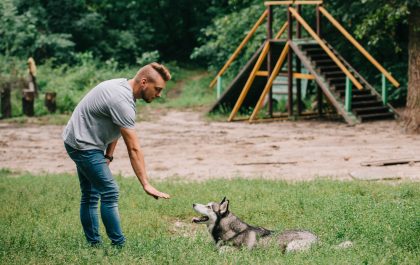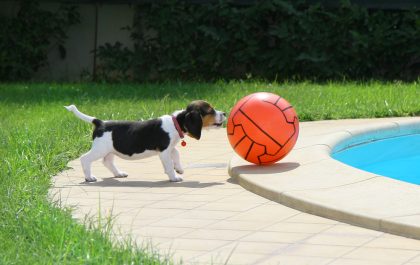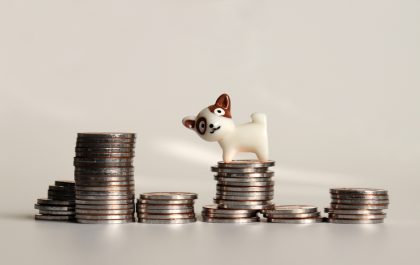Size: 20-28 cm at the shoulder
Weight: 8-11 kg
Coat: hard, wiry outer coat and a soft undercoat
colour: pepper or mustard
Temperament: loyal, affectionate, independent, and intelligent
Life span: 11-13 years
Health issues: spinal problems, glaucoma, and epilepsy
Exercise needs: moderate exercise, such as daily walks
Grooming needs: regular brushing and stripping of the coat
Training: firm and consistent training is necessary
If you’re looking to learn more about the Dandie Dinmont Terrier, you’ve come to the right place. This article will provide a comprehensive overview of this unique breed, from its physical characteristics to its history and temperament. You’ll also learn about the breed’s popularity and why it’s such a beloved companion. And if you read on, you’ll also discover a lot about the Chinese Crested Dog, which is closely related to the Dandie Dinmont Terrier. So keep reading and you’ll be an expert on these two breeds in no time!
History of the Dandie Dinmont Terrier breed
The Dandie Dinmont Terrier is a small breed of terrier that originated in the Borders region of Scotland in the 1700s. The breed was named after a character in the novel Guy Mannering by Sir Walter Scott, and was developed by local farmers to hunt badgers, otters, and other small game. The breed is known for its long body and short legs, as well as its distinctive topknot of hair on the head.
Today, the Dandie Dinmont Terrier is a popular companion dog in Australia and around the world. They are intelligent and loyal, and make excellent family pets. They are also active, and require regular exercise and mental stimulation to stay happy and healthy. They are also very good with children, and make excellent watchdogs. The Dandie Dinmont Terrier is a small breed that can live up to 15 years with proper care.
Physical characteristics and temperament of the Dandie Dinmont Terrier
The Dandie Dinmont Terrier is a small, sturdy breed of dog that is easily recognisable by its long body and short legs. It has a silky topknot of fur on its head, and a distinctive beard and moustache. Its coat is usually a mix of shades of grey, brown, and black, and its ears are folded flat against its head.
The Dandie Dinmont Terrier is an intelligent and loyal breed that makes a wonderful companion. It is an active breed that loves to play and explore, and is very affectionate with its family. It can be quite stubborn at times, and can be quite vocal, so it is important to provide it with consistent training and socialisation from a young age. It is an independent breed that is not overly clingy, but still loves to be around its family. The Dandie Dinmont Terrier is a great breed for those looking for a loyal and loving companion.
Training and socialization of Dandie Dinmont Terriers
The Dandie Dinmont Terrier is a unique breed of dog that requires specialised training and socialisation. As a small breed, they can be prone to anxiety and can become easily overwhelmed in unfamiliar situations. It is important to begin socialising your Dandie Dinmont Terrier from a young age, introducing them to different people, animals and environments. This will help them to become confident and comfortable in a variety of situations.
Training should also begin early, and should be consistent and positive. Dandie Dinmont Terriers are intelligent and eager to please, making them easy to train. It is important to use positive reinforcement and reward-based training, as this will help your Dandie Dinmont Terrier to understand what is expected of them. Training should focus on basic commands such as sit, stay and come, as well as good manners and social etiquette. This will help your Dandie Dinmont Terrier to become a well-rounded and socially responsible pet.
Health concerns and common medical issues in Dandie Dinmont Terriers
Dandie Dinmont Terriers are generally a healthy breed, but like all dogs, they can be prone to certain health concerns. The most common health issues associated with Dandie Dinmont Terriers are intervertebral disc disease, which is a condition that affects the discs between the vertebrae, and patellar luxation, which is a condition where the kneecap moves out of its normal position. Other health issues that can affect Dandie Dinmont Terriers include eye problems such as cataracts, glaucoma, and progressive retinal atrophy.
It is important to ensure that any Dandie Dinmont Terrier you are considering adopting or purchasing has been screened for these health issues. It is also important to have your Dandie Dinmont Terrier regularly examined by a veterinarian to ensure that any potential health issues are identified and treated promptly. Regular exercise and proper nutrition are also important for maintaining the overall health of your Dandie Dinmont Terrier.
Grooming and maintenance of Dandie Dinmont Terriers
The Dandie Dinmont Terrier is a small, hardy breed of dog that requires regular grooming and maintenance to ensure its health and wellbeing. This breed has a double coat that requires regular brushing and combing to prevent tangles and mats. The coat should be brushed at least twice a week, using a slicker brush and a comb to remove any knots or tangles. The coat should also be trimmed every two to three months to keep it in good condition.
The Dandie Dinmont Terrier should also have its nails trimmed regularly to prevent them from becoming too long and uncomfortable. The breed also requires regular ear cleaning to prevent infections. This should be done weekly using a cotton ball and a veterinarian-approved ear cleaner. The teeth should be brushed regularly with a toothbrush and toothpaste designed specifically for dogs. Finally, regular baths are recommended to keep the coat clean and healthy.
Dandie Dinmont Terriers as family pets and companions
Dandie Dinmont Terriers are a delightful breed of dog that make wonderful family pets and companions. These small and hardy dogs are native to the border country of Scotland and England, and have been popular in Australia for over a century. They are known for their distinctive look, with their long, low body and short legs, and their unique colouring. They are also known for their loyal and affectionate nature, and their intelligence and willingness to please.
These dogs are ideal for families who want a small but sturdy pet. They are easy to train and do not require a lot of exercise, making them suitable for those who have limited time or space. Dandie Dinmont Terriers are also known for their good-natured personalities, and they are known to get along well with children. They can be quite vocal, but this is often seen as part of their charm. They are also generally good with other animals, and can make a great companion for other pets in the household.
Breeding and showing Dandie Dinmont Terriers
Breeding and showing Dandie Dinmont Terriers is a popular pastime for many enthusiasts of this unique breed. The Dandie Dinmont Terrier is a small, long-bodied dog with a distinctive topknot of hair, and is recognised as a distinct breed by the British Kennel Club. Breeding and showing these dogs is a rewarding experience, and those who take part in these activities are dedicated to preserving the breed’s unique characteristics and temperament.
When breeding and showing Dandie Dinmont Terriers, it is important to ensure that the dogs are healthy and of good temperament. Prospective breeders should research the breed and its characteristics carefully before embarking on a breeding program. The breed has a number of specific requirements, such as coat colour, size and shape, which must be met in order to be successful in the show ring. Breeding and showing Dandie Dinmont Terriers is also a great way to meet other people who share a passion for the breed, and to learn more about its history and characteristics.
Final Thoughts
the Dandie Dinmont Terrier is a unique and beloved breed of dog that makes an excellent companion for families. They are intelligent, loyal, and affectionate, and are known for their distinctive look and good-natured personalities. They require regular exercise and mental stimulation to stay healthy and happy, and should be socialised and trained from a young age. They are prone to certain health issues, so it is important to have them regularly examined by a veterinarian. The Dandie Dinmont Terrier is also a popular breed for those who enjoy breeding and showing dogs, and can be a rewarding experience for those who are dedicated to preserving the breed’s unique characteristics and temperament. With proper care and attention, the Dandie Dinmont Terrier can be a wonderful addition to any family.
Dandie Dinmont Terrier FAQs
Dandie Dinmont Terriers can be good with children if they are properly socialized and trained. However, they may not tolerate rough play or excessive noise. It is important to always supervise interactions between children and dogs.
Like all breeds, Dandie Dinmont Terriers are prone to certain health issues such as hip dysplasia, epilepsy, and eye problems. It is important to buy from a reputable breeder who screens their dogs for these issues.
Dandie Dinmont Terriers can make great family pets for those who are willing to put in the time and effort to properly train and care for them. They require regular exercise and grooming, and may not be the best fit for those with young children or other pets. It is important to do research and meet the breed before making a decision.
Dandie Dinmont Terriers have a unique coat that requires regular grooming to prevent matting and tangling. They should be brushed at least once a week and taken to a professional groomer every 2-3 months.
The Dandie Dinmont Terrier is a small breed of dog originally bred for hunting small game such as otters and badgers. They are known for their unique appearance and charming personalities.
The average lifespan of a Dandie Dinmont Terrier is 12 to 15 years. With proper care, some may even live into their late teens.
Dandie Dinmont Terriers are small dogs, typically weighing between 8 to 11 kilograms and standing around 20 to 28 centimetres tall at the shoulder.
Dandie Dinmont Terriers are known for being intelligent, independent, and affectionate. They can be stubborn at times, but are generally friendly with both humans and other animals.
While they are small, Dandie Dinmont Terriers are active and require daily exercise. They enjoy long walks, playtime, and activities that challenge their minds such as puzzle toys and obedience training.
The Dandie Dinmont Terrier originated in the border country between England and Scotland in the 1700s. They were named after a character in Sir Walter Scott’s novel, Guy Mannering.





